The connected 3-regular (cubic) simple graphs are listed for small vertex numbers.
Connectivity
The number of connected simple cubic graphs on 4, 6, 8, 10, ... vertices is 1, 2, 5, 19, ... (sequence A002851 in the OEIS). A classification according to edge connectivity is made as follows: the 1-connected and 2-connected graphs are defined as usual. This leaves the other graphs in the 3-connected class because each 3-regular graph can be split by cutting all edges adjacent to any of the vertices. To refine this definition in the light of the algebra of coupling of angular momenta (see below), a subdivision of the 3-connected graphs is helpful. We shall call
- Non-trivially 3-connected those that can be split by 3 edge cuts into sub-graphs with at least two vertices remaining in each part
- Cyclically 4-connected—all those not 1-connected, not 2-connected, and not non-trivially 3-connected
This declares the numbers 3 and 4 in the fourth column of the tables below.
Pictures
Ball-and-stick models of the graphs in another column of the table show the vertices and edges in the style of images of molecular bonds. Comments on the individual pictures contain girth, diameter, Wiener index, Estrada index and Kirchhoff index. Aut is the order of the Automorphism group of the graph. A Hamiltonian circuit (where present) is indicated by enumerating vertices along that path from 1 upwards. (The positions of the vertices have been defined by minimizing a pair potential defined by the squared difference of the Euclidean and graph theoretic distance, placed in a Molfile, then rendered by Jmol.)
LCF notation
The LCF notation is a notation by Joshua Lederberg, Coxeter and Frucht, for the representation of cubic graphs that are Hamiltonian.
The two edges along the cycle adjacent to any of the vertices are not written down.
Let v be the vertices of the graph and describe the Hamiltonian circle along the p vertices by the edge sequence v0v1, v1v2, ...,vp−2vp−1, vp−1v0. Halting at a vertex vi, there is one unique vertex vj at a distance di joined by a chord with vi,
The vector [d0, d1, ..., dp−1] of the p integers is a suitable, although not unique, representation of the cubic Hamiltonian graph. This is augmented by two additional rules:
- If a di > p/2, replace it by di − p;
- avoid repetition of a sequence of di if these are periodic and replace them by an exponential notation.
Since the starting vertex of the path is of no importance, the numbers in the representation may be cyclically permuted. If a graph contains different Hamiltonian circuits, one may select one of these to accommodate the notation. The same graph may have different LCF notations, depending on precisely how the vertices are arranged.
Often the anti-palindromic representations with
are preferred (if they exist), and the redundant part is then replaced by a semicolon and a dash "; –". The LCF notation [5, −9, 7, −7, 9, −5]4, for example, and would at that stage be condensed to [5, −9, 7; –]4.
Table
4 vertices
| diam. | girth | Aut. | connect. | LCF | names | picture |
| 1 | 3 | 24 | 4 | [2]4 | K4 |  4 vertices and 6 edges. Yutsis graph of the 6-j symbol |
6 vertices
| diam. | girth | Aut. | connect. | LCF | names | picture |
| 2 | 3 | 12 | 3 | [2, 3, −2]2 | prism graph Y3 |  6 vertices and 9 edges |
| 2 | 4 | 72 | 4 | [3]6 | K3, 3, utility graph | 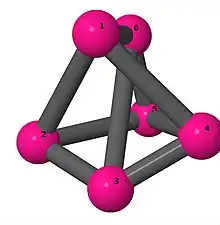 6 vertices and 9 edges. Yutsis graph of the 9-j symbol. |
8 vertices
| diam. | girth | Aut. | connect. | LCF | names | pictures |
| 3 | 3 | 16 | 2 | [2, 2, −2, −2]2 |  8 vertices and 12 edges | |
| 3 | 3 | 4 | 3 | [4, −2, 4, 2]2 or [2, 3, −2, 3; –] |  8 vertices and 12 edges | |
| 2 | 3 | 12 | 3 | [2, 4, −2, 3, 3, 4, −3, −3] | 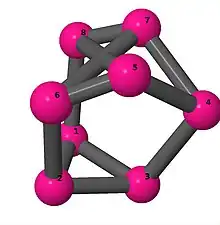 8 vertices and 12 edges | |
| 3 | 4 | 48 | 4 | [−3, 3]4 | cubical graph | 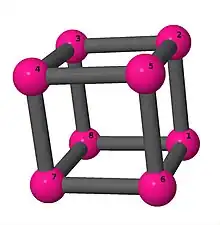 8 vertices and 12 edges. Yutsis graph of the 12j-symbol of the second kind. |
| 2 | 4 | 16 | 4 | [4]8 or [4, −3, 3, 4]2 | Wagner graph |  8 vertices and 12 edges. Yutsis graph of the 12j-symbol of the first kind. |
10 vertices
| diam. | girth | Aut. | connect. | LCF | names | pictures |
| 5 | 3 | 32 | 1 | Edge list 0–1, 0–6, 0–9, 1–2, 1–5, 2–3, 2–4, 3–4, 3–5, 4–5, 6–7, 6–8, 7–8, 7–9, 8–9 |  10 vertices and 15 edges | |
| 4 | 3 | 4 | 2 | [4, 2, 3, −2, −4, −3, 2, 2, −2, −2] |  | |
| 3 | 3 | 8 | 2 | [2, −3, −2, 2, 2; –] |  | |
| 3 | 3 | 16 | 2 | [−2, −2, 3, 3, 3; –] |  | |
| 4 | 3 | 16 | 2 | [2, 2, −2, −2, 5]2 |  | |
| 3 | 3 | 2 | 3 | [2, 3, −2, 5, −3]2 [3, −2, 4, −3, 4, 2, −4, −2, −4, 2] | 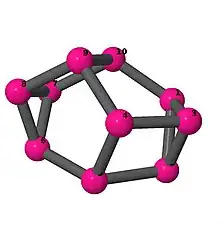 | |
| 3 | 3 | 12 | 3 | [2, −4, −2, 5, 2, 4, −2, 4, 5, −4] | 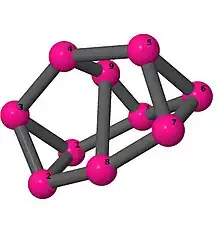 10 vertices and 15 edges | |
| 3 | 3 | 2 | 3 | [5, 3, 5, −4, −3, 5, 2, 5, −2, 4] [−4, 2, 5, −2, 4, 4, 4, 5, −4, −4] [−3, 2, 4, −2, 4, 4, −4, 3, −4, −4] |  10 vertices and 15 edges | |
| 3 | 3 | 4 | 3 | [−4, 3, 3, 5, −3, −3, 4, 2, 5, −2] [3, −4, −3, −3, 2, 3, −2, 4, −3, 3] |  | |
| 3 | 3 | 6 | 3 | [3, −3, 5, −3, 2, 4, −2, 5, 3, −4] |  | |
| 3 | 3 | 4 | 3 | [2, 3, −2, 3, −3; –] [−4, 4, 2, 5, −2]2 | 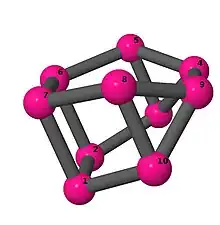 | |
| 3 | 3 | 6 | 3 | [5, −2, 2, 4, −2, 5, 2, −4, −2, 2] | 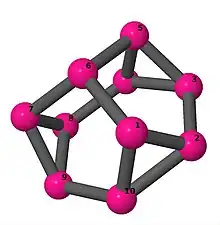 | |
| 3 | 3 | 8 | 3 | [2, 5, −2, 5, 5]2 [2, 4, −2, 3, 4; –] |  10 vertices and 15 edges | |
| 3 | 4 | 48 | 3 | [5, −3, −3, 3, 3]2 |  | |
| 3 | 4 | 8 | 4 | [5, −4, 4, −4, 4]2 [5, −4, −3, 3, 4, 5, −3, 4, −4, 3] | 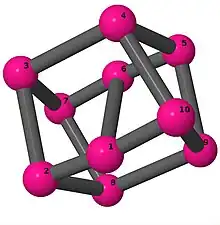 Yutsis graph of the 15j-symbol of the third kind. | |
| 3 | 4 | 4 | 4 | [5, −4, 4, 5, 5]2 [−3, 4, −3, 3, 4; –] [4, −3, 4, 4, −4; –] [−4, 3, 5, 5, −3, 4, 4, 5, 5, −4] |  Yutsis graph of the 15j-symbol of the fourth kind. | |
| 3 | 4 | 20 | 4 | [5]10 [−3, 3]5 [5, 5, −3, 5, 3]2 | 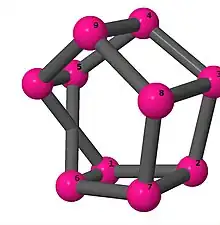 Yutsis graph of the 15j-symbol of the first kind. | |
| 3 | 4 | 20 | 4 | [−4, 4, −3, 5, 3]2 | Pentagonal prism, G5, 2 | 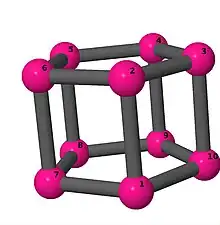 Yutsis graph of the 15j-symbol of the second kind. |
| 2 | 5 | 120 | 4 | Petersen graph | 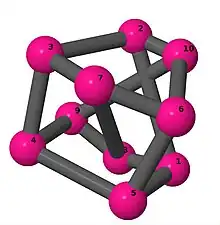 Yutsis graph of the 15j-symbol of the fifth kind. |
12 vertices
| diam. | girth | Aut. | connect. | LCF | names | picture |
| 6 | 3 | 16 | 1 | Edge list 0–1, 0–2, 0–11, 1–2, 1–6, 2–3, 3–4, 3–5, 4–5, 4–6, 5–6, 7–8, 7–9, 7–11, 8–9, 8–10, 9–10, 10–11 | 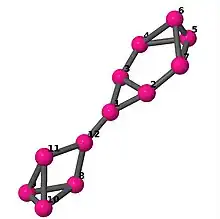 | |
| 5 | 3 | 16 | 1 | Edge list 0–1, 0–6, 0–11, 1–2, 1–3, 2–3, 2–5, 3–4, 4–5, 4–6, 5–6, 7–8, 7–9, 7–11, 8–9, 8–10, 9–10, 10–11 | 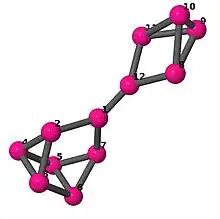 | |
| 6 | 3 | 8 | 1 | Edge list 0–1, 0–3, 0–11, 1–2, 1–6, 2–3, 2–5, 3–4, 4–5, 4–6, 5–6, 7–8, 7–9, 7–11, 8–9, 8–10, 9–10, 10–11 | 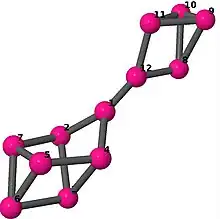 | |
| 5 | 3 | 32 | 1 | Edge list 0–1, 0–6, 0–11, 1–2, 1–4, 2–3, 2–5, 3–4, 3–6, 4–5, 5–6, 7–8, 7–9, 7–11, 8–9, 8–10, 9–10, 10–11 | 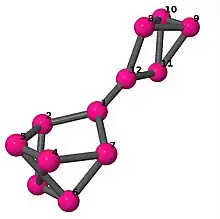 | |
| 5 | 3 | 4 | 2 | [3, −2, −4, −3, 4, 2]2 [4, 2, 3, −2, −4, −3; –] | 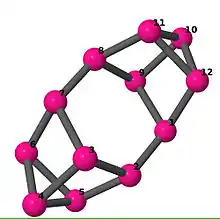 | |
| 4 | 3 | 8 | 2 | [3, −2, −4, −3, 3, 3, 3, −3, −3, −3, 4, 2] |  | |
| 4 | 3 | 4 | 2 | [4, 2, 3, −2, −4, −3, 2, 3, −2, 2, −3, −2] | 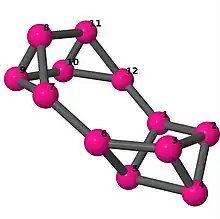 | |
| 4 | 4 | 64 | 2 | [3, 3, 3, −3, −3, −3]2 | 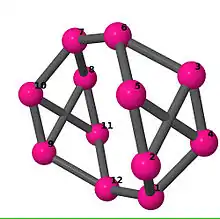 | |
| 4 | 3 | 16 | 2 | [2, −3, −2, 3, 3, 3; –] |  | |
| 4 | 3 | 16 | 2 | [2, 3, −2, 2, −3, −2]2 | 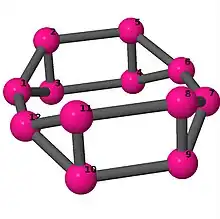 | |
| 4 | 3 | 2 | 2 | [−2, 3, 6, 3, −3, 2, −3, −2, 6, 2, 2, −2] [4, 2, −4, −2, −4, 6, 2, 2, −2, −2, 4, 6] | 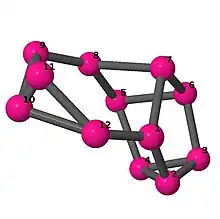 | |
| 4 | 3 | 8 | 2 | [6, 3, 3, 4, −3, −3, 6, −4, 2, 2, −2, −2] |  | |
| 5 | 3 | 4 | 2 | [4, 2, 3, −2, −4, −3, 5, 2, 2, −2, −2, −5] |  | |
| 4 | 3 | 16 | 2 | [−3, −3, −3, 5, 2, 2; –] |  | |
| 4 | 3 | 8 | 2 | [2, −3, −2, 5, 2, 2; –] | 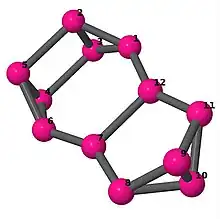 | |
| 4 | 3 | 4 | 2 | [2, 4, −2, 3, −5, −4, −3, 2, 2, −2, −2, 5] [5, 2, −4, −2, −5, −5, 2, 2, −2, −2, 4, 5] |  | |
| 4 | 3 | 4 | 2 | [−2, −2, 4, 4, 4, 4; –] [3, −4, −4, −3, 2, 2; –] [5, 3, 4, 4, −3, −5, −4, −4, 2, 2, −2, −2] |  | |
| 4 | 3 | 2 | 2 | [4, −2, 4, 2, −4, −2, −4, 2, 2, −2, −2, 2] [5, −2, 2, 3, −2, −5, −3, 2, 2, −2, −2, 2] | 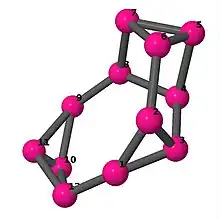 | |
| 5 | 3 | 16 | 2 | [2, 2, −2, −2, −5, 5]2 | 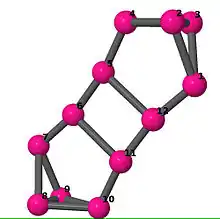 | |
| 4 | 3 | 8 | 2 | [−2, −2, 4, 5, 3, 4; –] | 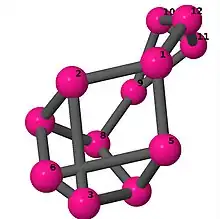 | |
| 4 | 3 | 4 | 2 | [5, 2, −3, −2, 6, −5, 2, 2, −2, −2, 6, 3] | 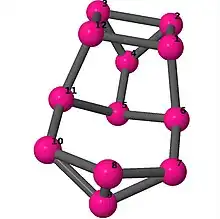 | |
| 4 | 3 | 8 | 2 | [4, −2, 3, 3, −4, −3, −3, 2, 2, −2, −2, 2] | 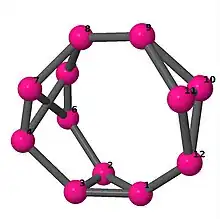 | |
| 4 | 3 | 8 | 2 | [−2, −2, 5, 3, 5, 3; –] [−2, −2, 3, 5, 3, −3; –] | 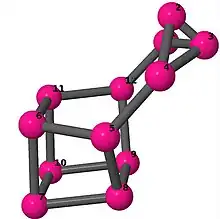 | |
| 5 | 3 | 32 | 2 | [2, 2, −2, −2, 6, 6]2 | 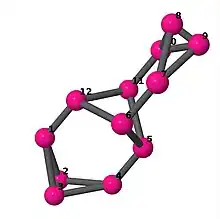 | |
| 4 | 3 | 8 | 2 | [−3, 2, −3, −2, 2, 2; –] |  | |
| 4 | 3 | 8 | 2 | [−2, −2, 5, 2, 5, −2; –] |  | |
| 4 | 3 | 8 | 2 | [6, −2, 2, 2, −2, −2, 6, 2, 2, −2, −2, 2] | 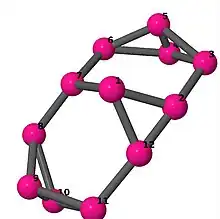 | |
| 4 | 3 | 48 | 2 | [−2, −2, 2, 2]3 | 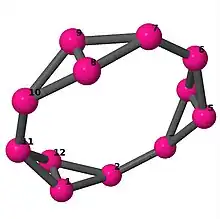 | |
| 4 | 3 | 4 | 3 | [2, 3, −2, 3, −3, 3; –] [−4, 6, 4, 2, 6, −2]2 | 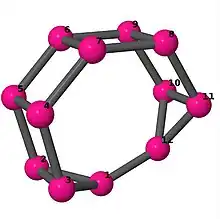 | |
| 4 | 3 | 4 | 3 | [−4, 6, 3, 3, 6, −3, −3, 6, 4, 2, 6, −2] [−2, 3, −3, 4, −3, 3, 3, −4, −3, −3, 2, 3] | 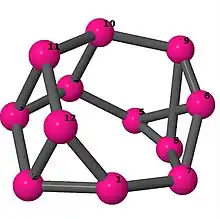 | |
| 4 | 3 | 1 | 3 | [−5, 2, −3, −2, 6, 4, 2, 5, −2, −4, 6, 3] [−2, 3, −3, 4, −3, 4, 2, −4, −2, −4, 2, 3] [3, −2, 3, −3, 5, −3, 2, 3, −2, −5, −3, 2] | 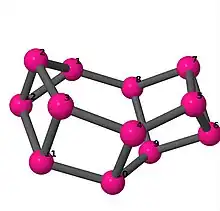 | |
| 3 | 3 | 4 | 3 | [−5, −5, 4, 2, 6, −2, −4, 5, 5, 2, 6, −2] [4, −2, 3, 4, −4, −3, 3, −4, 2, −3, −2, 2] | 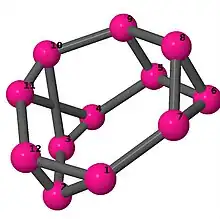 | |
| 3 | 3 | 8 | 3 | [−5, −5, 3, 3, 6, −3, −3, 5, 5, 2, 6, −2] [2, 4, −2, 3, 5, −4, −3, 3, 3, −5, −3, −3] |  | |
| 4 | 3 | 2 | 3 | [2, 4, −2, 3, 6, −4, −3, 2, 3, −2, 6, −3] [2, 4, −2, 3, 5, −4, −3, 4, 2, −5, −2, −4] [−5, 2, −3, −2, 5, 5, 2, 5, −2, −5, −5, 3] |  | |
| 4 | 3 | 2 | 3 | [−5, 2, −3, −2, 6, 3, 3, 5, −3, −3, 6, 3] [4, −2, −4, 4, −4, 3, 3, −4, −3, −3, 4, 2] [−3, 3, 3, 4, −3, −3, 5, −4, 2, 3, −2, −5] |  | |
| 4 | 3 | 2 | 3 | [2, 3, −2, 4, −3, 6, 3, −4, 2, −3, −2, 6] [−4, 5, −4, 2, 3, −2, −5, −3, 4, 2, 4, −2] | 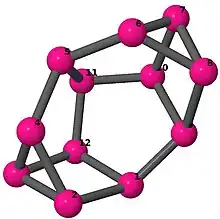 | |
| 4 | 3 | 1 | 3 | [6, 3, −4, −4, −3, 3, 6, 2, −3, −2, 4, 4] [−5, −4, 4, 2, 6, −2, −4, 5, 3, 4, 6, −3] [3, 4, 4, −3, 4, −4, −4, 3, −4, 2, −3, −2] [4, 5, −4, −4, −4, 3, −5, 2, −3, −2, 4, 4] [4, 5, −3, −5, −4, 3, −5, 2, −3, −2, 5, 3] | 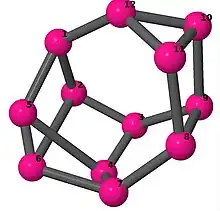 | |
| 3 | 4 | 4 | 3 | [4, 6, −4, −4, −4, 3, 3, 6, −3, −3, 4, 4] [−5, −4, 3, 3, 6, −3, −3, 5, 3, 4, 6, −3] [4, −3, 5, −4, −4, 3, 3, −5, −3, −3, 3, 4] | 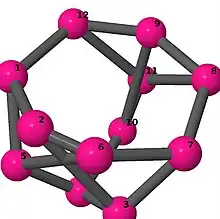 | |
| 3 | 4 | 16 | 3 | [3, 3, 4, −3, −3, 4; –] [3, 6, −3, −3, 6, 3]2 |  | |
| 4 | 3 | 1 | 3 | [4, −2, 5, 2, −4, −2, 3, −5, 2, −3, −2, 2] [5, −2, 2, 4, −2, −5, 3, −4, 2, −3, −2, 2] [2, −5, −2, −4, 2, 5, −2, 2, 5, −2, −5, 4] | Frucht graph |  |
| 4 | 3 | 4 | 3 | [−2, 6, 2, −4, −2, 3, 3, 6, −3, −3, 2, 4] [−2, 2, 5, −2, −5, 3, 3, −5, −3, −3, 2, 5] |  | |
| 4 | 3 | 2 | 3 | [2, 4, −2, 6, 2, −4, −2, 4, 2, 6, −2, −4] [2, 5, −2, 2, 6, −2, −5, 2, 3, −2, 6, −3] | 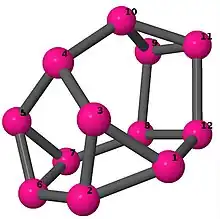 | |
| 4 | 3 | 2 | 3 | [6, 3, −3, −5, −3, 3, 6, 2, −3, −2, 5, 3] [3, 5, 3, −3, 4, −3, −5, 3, −4, 2, −3, −2] [−5, −3, 4, 2, 5, −2, −4, 5, 3, −5, 3, −3] | 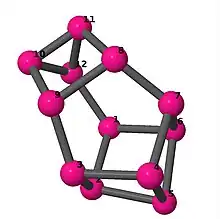 | |
| 4 | 4 | 12 | 3 | [3, −3, 5, −3, −5, 3, 3, −5, −3, −3, 3, 5] | 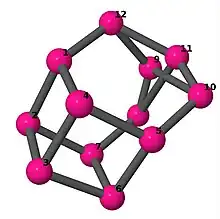 | |
| 4 | 3 | 2 | 3 | [4, 2, 4, −2, −4, 4; –] [3, 5, 2, −3, −2, 5; –] [6, 2, −3, −2, 6, 3]2 | 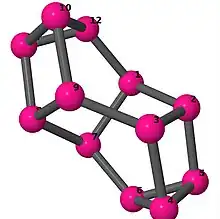 | |
| 4 | 3 | 2 | 3 | [3, 6, 4, −3, 6, 3, −4, 6, −3, 2, 6, −2] [4, −4, 5, 3, −4, 6, −3, −5, 2, 4, −2, 6] [−5, 5, 3, −5, 4, −3, −5, 5, −4, 2, 5, −2] | 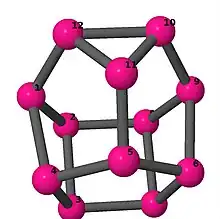 | |
| 3 | 3 | 1 | 3 | [6, −5, 2, 6, −2, 6, 6, 3, 5, 6, −3, 6] [6, 2, −5, −2, 4, 6, 6, 3, −4, 5, −3, 6] [5, 5, 6, 4, 6, −5, −5, −4, 6, 2, 6, −2] [−4, 4, −3, 3, 6, −4, −3, 2, 4, −2, 6, 3] [6, 2, −4, −2, 4, 4, 6, 4, −4, −4, 4, −4] [−3, 2, 5, −2, −5, 3, 4, −5, −3, 3, −4, 5] [−5, 2, −4, −2, 4, 4, 5, 5, −4, −4, 4, −5] | 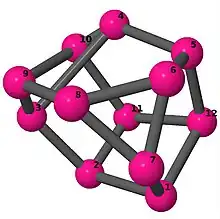 | |
| 3 | 3 | 2 | 3 | [2, 6, −2, 5, 6, 4, 5, 6, −5, −4, 6, −5] [5, 6, −4, −4, 5, −5, 2, 6, −2, −5, 4, 4] [2, 4, −2, −5, 4, −4, 3, 4, −4, −3, 5, −4] [2, −5, −2, 4, −5, 4, 4, −4, 5, −4, −4, 5] |  | |
| 4 | 3 | 4 | 3 | [2, 4, −2, −5, 5]2 [−5, 2, 4, −2, 6, 3, −4, 5, −3, 2, 6, −2] | 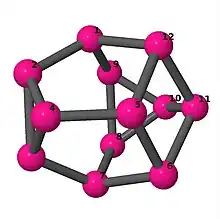 | |
| 4 | 3 | 2 | 3 | [−4, −4, 4, 2, 6, −2, −4, 4, 4, 4, 6, −4] [−4, −3, 4, 2, 5, −2, −4, 4, 4, −5, 3, −4] [−3, 5, 3, 4, −5, −3, −5, −4, 2, 3, −2, 5] | 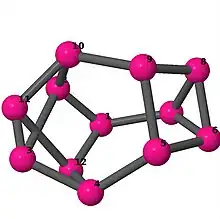 | |
| 3 | 3 | 2 | 3 | [2, 5, −2, 4, 4, 5; –] [2, 4, −2, 4, 4, −4; –] [−5, 5, 6, 2, 6, −2]2 [5, −2, 4, 6, 3, −5, −4, −3, 2, 6, −2, 2] | 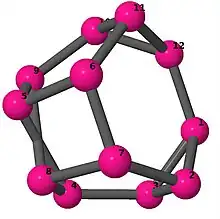 | |
| 3 | 3 | 2 | 3 | [3, 6, −4, −3, 5, 6, 2, 6, −2, −5, 4, 6] [2, −5, −2, 4, 5, 6, 4, −4, 5, −5, −4, 6] [5, −4, 4, −4, 3, −5, −4, −3, 2, 4, −2, 4] |  | |
| 4 | 3 | 2 | 3 | [6, −5, 2, 4, −2, 5, 6, −4, 5, 2, −5, −2] [−2, 4, 5, 6, −5, −4, 2, −5, −2, 6, 2, 5] [5, −2, 4, −5, 4, −5, −4, 2, −4, −2, 5, 2] |  | |
| 4 | 3 | 1 | 3 | [2, −5, −2, 6, 3, 6, 4, −3, 5, 6, −4, 6] [6, 3, −3, 4, −3, 4, 6, −4, 2, −4, −2, 3] [5, −4, 6, −4, 2, −5, −2, 3, 6, 4, −3, 4] [5, −3, 5, 6, 2, −5, −2, −5, 3, 6, 3, −3] [−5, 2, −5, −2, 6, 3, 5, 5, −3, 5, 6, −5] [−3, 4, 5, −5, −5, −4, 2, −5, −2, 3, 5, 5] [5, 5, 5, −5, 4, −5, −5, −5, −4, 2, 5, −2] |  | |
| 3 | 3 | 2 | 3 | [5, −3, 6, 3, −5, −5, −3, 2, 6, −2, 3, 5] [2, 6, −2, −5, 5, 3, 5, 6, −3, −5, 5, −5] [5, 5, 5, 6, −5, −5, −5, −5, 2, 6, −2, 5] [4, −3, 5, 2, −4, −2, 3, −5, 3, −3, 3, −3] [5, 5, −3, −5, 4, −5, −5, 2, −4, −2, 5, 3] |  | |
| 4 | 3 | 4 | 3 | [2, 4, −2, 5, 3, −4; –] [5, −3, 2, 5, −2, −5; –] [3, 6, 3, −3, 6, −3, 2, 6, −2, 2, 6, −2] |  | |
| 4 | 3 | 2 | 3 | [6, 2, −4, −2, −5, 3, 6, 2, −3, −2, 4, 5] [2, 3, −2, 4, −3, 4, 5, −4, 2, −4, −2, −5] [−5, 2, −4, −2, −5, 4, 2, 5, −2, −4, 4, 5] | 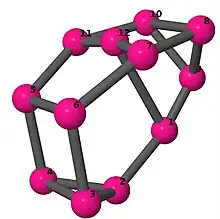 | |
| 3 | 3 | 2 | 3 | [5, 2, 5, −2, 5, −5; –] [6, 2, −4, −2, 4, 6]2 [2, −5, −2, 6, 2, 6, −2, 3, 5, 6, −3, 6] [−5, −2, 6, 6, 2, 5, −2, 5, 6, 6, −5, 2] | 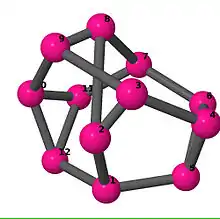 | |
| 3 | 3 | 12 | 3 | [−5, 3, 3, 5, −3, −3, 4, 5, −5, 2, −4, −2] | 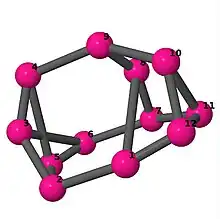 | |
| 3 | 3 | 2 | 3 | [6, −4, 3, 4, −5, −3, 6, −4, 2, 4, −2, 5] [−4, 6, −4, 2, 5, −2, 5, 6, 4, −5, 4, −5] [5, −5, 4, −5, 3, −5, −4, −3, 5, 2, 5, −2] | 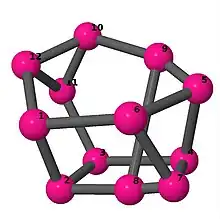 | |
| 4 | 3 | 12 | 3 | [−4, 5, 2, −4, −2, 5; –] | Dürer graph |  |
| 3 | 3 | 4 | 3 | [2, 5, −2, 5, 3, 5; –] [6, −2, 6, 6, 6, 2]2 [5, −2, 6, 6, 2, −5, −2, 3, 6, 6, −3, 2] | 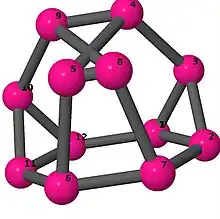 | |
| 3 | 3 | 4 | 3 | [6, −2, 6, 4, 6, 4, 6, −4, 6, −4, 6, 2] [5, 6, −3, 3, 5, −5, −3, 6, 2, −5, −2, 3] |  | |
| 3 | 3 | 4 | 3 | [4, −2, 4, 6, −4, 2, −4, −2, 2, 6, −2, 2] [5, −2, 5, 6, 2, −5, −2, −5, 2, 6, −2, 2] |  | |
| 3 | 3 | 24 | 3 | [6, −2, 2]4 | Truncated tetrahedron | 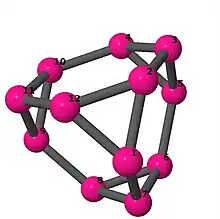 |
| 3 | 3 | 12 | 3 | Tietze's Graph | 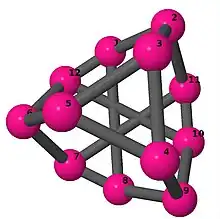 | |
| 3 | 3 | 36 | 3 | [2, 6, −2, 6]3 | 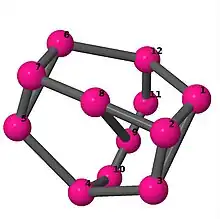 | |
| 4 | 4 | 24 | 4 | [−3, 3]6 [3, −5, 5, −3, −5, 5]2 | G6, 2, Y6 |  Yutsis 18j-symbol label: B |
| 3 | 4 | 4 | 4 | [6, −3, 6, 6, 3, 6]2 [6, 6, −5, 5, 6, 6]2 [3, −3, 4, −3, 3, 4; –] [5, −3, 6, 6, 3, −5]2 [5, −3, −5, 4, 4, −5; –] [6, 6, −3, −5, 4, 4, 6, 6, −4, −4, 5, 3] | 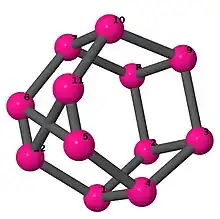 Yutsis 18j-symbol label: L | |
| 3 | 4 | 8 | 4 | [−4, 4, 4, 6, 6, −4]2 [6, −5, 5, −5, 5, 6]2 [4, −3, 3, 5, −4, −3; –] [−4, −4, 4, 4, −5, 5]2 | 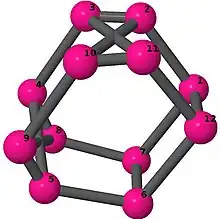 Yutsis 18j-symbol label: K | |
| 3 | 4 | 2 | 4 | [−4, 6, 3, 6, 6, −3, 5, 6, 4, 6, 6, −5] [−5, 4, 6, 6, 6, −4, 5, 5, 6, 6, 6, −5] [5, −3, 4, 6, 3, −5, −4, −3, 3, 6, 3, −3] [4, −4, 6, 4, −4, 5, 5, −4, 6, 4, −5, −5] [4, −5, −3, 4, −4, 5, 3, −4, 5, −3, −5, 3] |  Yutsis 18j-symbol label: T | |
| 3 | 4 | 2 | 4 | [3, 4, 5, −3, 5, −4; –] [3, 6, −4, −3, 4, 6]2 [−4, 5, 5, −4, 5, 5; –] [3, 6, −4, −3, 4, 4, 5, 6, −4, −4, 4, −5] [4, −5, 5, 6, −4, 5, 5, −5, 5, 6, −5, −5] [4, −4, 5, −4, −4, 3, 4, −5, −3, 4, −4, 4] |  Yutsis 18j-symbol label: R | |
| 3 | 4 | 8 | 4 | [4, −4, 6]4 [3, 6, 3, −3, 6, −3]2 [−3, 6, 4, −4, 6, 3, −4, 6, −3, 3, 6, 4] | Bidiakis cube |  Yutsis 18j-symbol label: D |
| 3 | 4 | 16 | 4 | [6, −5, 5]4 [3, 4, −4, −3, 4, −4]2 | 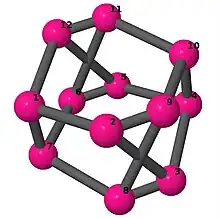 Yutsis 18j-symbol label: G | |
| 3 | 4 | 2 | 4 | [−3, 5, −3, 4, 4, 5; –] [4, −5, 5, 6, −4, 6]2 [−3, 4, −3, 4, 4, −4; –] [5, 6, −3, −5, 4, −5, 3, 6, −4, −3, 5, 3] [5, 6, 4, −5, 5, −5, −4, 6, 3, −5, 5, −3] | 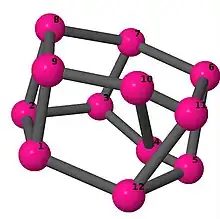 Yutsis 18j-symbol label: S | |
| 3 | 4 | 4 | 4 | [4, −3, 4, 5, −4, 4; –] [4, 5, −5, 5, −4, 5; –] [−5, −3, 4, 5, −5, 4; –] | 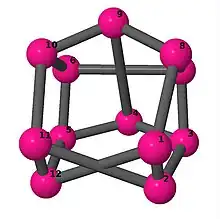 Yutsis 18j-symbol label: N | |
| 3 | 4 | 2 | 4 | [6, −4, 6, −4, 3, 5, 6, −3, 6, 4, −5, 4] [6, −4, 3, −4, 4, −3, 6, 3, −4, 4, −3, 4] [5, 6, −4, 3, 5, −5, −3, 6, 3, −5, 4, −3] [5, −5, 4, 6, −5, −5, −4, 3, 5, 6, −3, 5] [5, 5, −4, 4, 5, −5, −5, −4, 3, −5, 4, −3] | 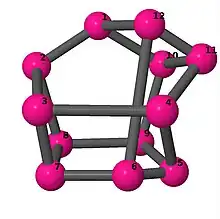 Yutsis 18j-symbol label: V | |
| 3 | 4 | 4 | 4 | [6, −3, 5, 6, −5, 3, 6, −5, −3, 6, 3, 5] [3, −4, 5, −3, 4, 6, 4, −5, −4, 4, −4, 6] | 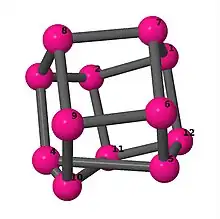 Yutsis 18j-symbol label: P | |
| 3 | 4 | 8 | 4 | [5, 6, 6, −4, 5, −5, 4, 6, 6, −5, −4, 4] |  Yutsis 18j-symbol label: I | |
| 3 | 5 | 16 | 4 | [4, −5, 4, −5, −4, 4; –] | 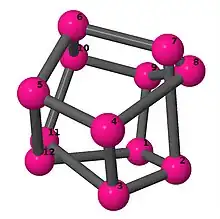 Yutsis 18j-symbol label: F | |
| 3 | 4 | 4 | 4 | [6, 4, 6, 6, 6, −4]2 [−3, 4, −3, 5, 3, −4; –] [−5, 3, 6, 6, −3, 5, 5, 5, 6, 6, −5, −5] [−3, 3, 6, 4, −3, 5, 5, −4, 6, 3, −5, −5] |  Yutsis 18j-symbol label: M | |
| 4 | 4 | 8 | 4 | [3, 5, 5, −3, 5, 5; –] [−3, 5, −3, 5, 3, 5; –] [5, −3, 5, 5, 5, −5; –] |  Yutsis 18j-symbol label: E | |
| 3 | 4 | 48 | 4 | [5, −5, −3, 3]3 [−5, 5]6 | Franklin graph | 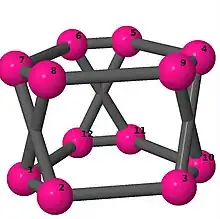 Yutsis 18j-symbol label: C |
| 3 | 4 | 24 | 4 | [6]12 [6, 6, −3, −5, 5, 3]2 |  Yutsis 18j-symbol label: A | |
| 3 | 5 | 18 | 4 | [6, −5, −4, 4, −5, 4, 6, −4, 5, −4, 4, 5] |  Yutsis 18j-symbol label: H |
The LCF entries are absent above if the graph has no Hamiltonian cycle, which is rare (see Tait's conjecture). In this case a list of edges between pairs of vertices labeled 0 to n−1 in the third column serves as an identifier.
Vector coupling coefficients
Each 4-connected (in the above sense) simple cubic graph on 2n vertices defines a class of quantum mechanical 3n-j symbols. Roughly speaking, each vertex represents a 3-jm symbol, the graph is converted to a digraph by assigning signs to the angular momentum quantum numbers j, the vertices are labelled with a handedness representing the order of the three j (of the three edges) in the 3-jm symbol, and the graph represents a sum over the product of all these numbers assigned to the vertices.
There are 1 (6-j), 1 (9-j), 2 (12-j), 5 (15-j), 18 (18-j), 84 (21-j), 607 (24-j), 6100 (27-j), 78824 (30-j), 1195280 (33-j), 20297600 (36-j), 376940415 (39-j) etc. of these (sequence A175847 in the OEIS).
If they are equivalent to certain vertex-induced binary trees (cutting one edge and finding a cut that splits the remaining graph into two trees), they are representations of recoupling coefficients, and are then also known as Yutsis graphs (sequence A111916 in the OEIS).
See also
References
- Yutsis, A. P.; Levinson, I. B.; Vanagas, V. V.; Sen, A. (1962). Mathematical Apparatus of the theory of angular momentum. Israel program for scientific translations. Bibcode:1962mata.book.....Y.
- Massot, J.-N.; El-Baz, E.; Lafoucriere, J. (1967). "A general graphical method for angular momentum". Reviews of Modern Physics. 39 (2): 288–305. Bibcode:1967RvMp...39..288M. doi:10.1103/RevModPhys.39.288.
- Bussemaker, F. C.; Cobeljic, S.; Cvetkovic, D. M. (1976). "Computer investigations of cubic graphs" (PDF).
- Bussemaker, F. C.; Cobeljic, S.; Cvetkovic, D. M.; Seidel, J. J. (1977). "Cubic graphs on <=14 vertices". J. Combin. Theory Ser. B. 23 (2–3): 234–235. doi:10.1016/0095-8956(77)90034-X.
- Frucht, R. (1977). "A canonical representation of trivalent Hamiltonian graphs". Journal of Graph Theory. 1 (1): 45–60. doi:10.1002/jgt.3190010111. MR 0463029.
- Clark, L.; Entringer, R. (1983). "Smallest maximally non-Hamiltonian graphs". Per. Mathem. Hungar. 14 (1): 57–68. doi:10.1007/BF02023582. MR 0697357. S2CID 122218690.
- Wormald, N. C. (1985). "Enumeration of cyclically 4-connected cubic graphs". Journal of Graph Theory. 9 (4): 563–573. doi:10.1002/jgt.3190090418. MR 0890248.
- Bar-Shalom, A.; Klapisch, M. (1988). "NJGRAF - an efficient program for calculation of general recoupling coefficients by graphical analysis, compatible with NJSYM". Comput. Phys. Commun. 50 (3): 375–393. Bibcode:1988CoPhC..50..375B. doi:10.1016/0010-4655(88)90192-0.
- Brinkmann, G. (1996). "Fast generation of cubic graphs". Journal of Graph Theory. 23 (2): 139–149. doi:10.1002/(SICI)1097-0118(199610)23:2<139::AID-JGT5>3.0.CO;2-U. MR 1408342.
- Fack, V.; Pitre, S. N.; Van der Jeugt, J. (1997). "Calculation of general recoupling coefficients using graphical methods". Comput. Phys. Commun. 101 (1–2): 155–170. Bibcode:1997CoPhC.101..155F. doi:10.1016/S0010-4655(96)00170-1.
- Danos, M.; Fano, U. (1998). "Graphical analysis of angular momentum for collision products". Physics Reports. 304 (4): 155–227. Bibcode:1998PhR...304..155D. doi:10.1016/S0370-1573(98)00020-9.
- Meringer, M. (1999). "Fast generation of regular graphs and construction of cages". Journal of Graph Theory. 30 (2): 137–146. doi:10.1002/(SICI)1097-0118(199902)30:2<137::AID-JGT7>3.0.CO;2-G. MR 1665972.
- Van Dyck, D.; Brinkmann, G.; Fack, V.; McKay, B. D. (2005). "To be or not to be Yutsis: Algorithms for the decision problem". Comput. Phys. Commun. 173 (1–2): 61–70. Bibcode:2005CoPhC.173...61V. doi:10.1016/j.cpc.2005.07.008. MR 2179511.
- Van Dyck, D.; Fack, V. (2007). "On the reduction of Yutsis graphs". Discrete Math. 307 (11–12): 1506–1515. doi:10.1016/j.disc.2005.11.088. MR 2311125.
- Aldred, R. E. L.; Van Dyck, D.; Brinkmann, G.; Fack, V.; McKay, B. D. (2009). "Graph structural properties of non-Yutsis graphs allowing fast recognition". Discrete Math. 157 (2): 377–386. doi:10.1016/j.dam.2008.03.020. hdl:1942/9184. MR 2479811.
- Mathar, Richard J. (2011). "The Wigner graphs up to 12 Vertices". arXiv:1109.2358 [math-ph].